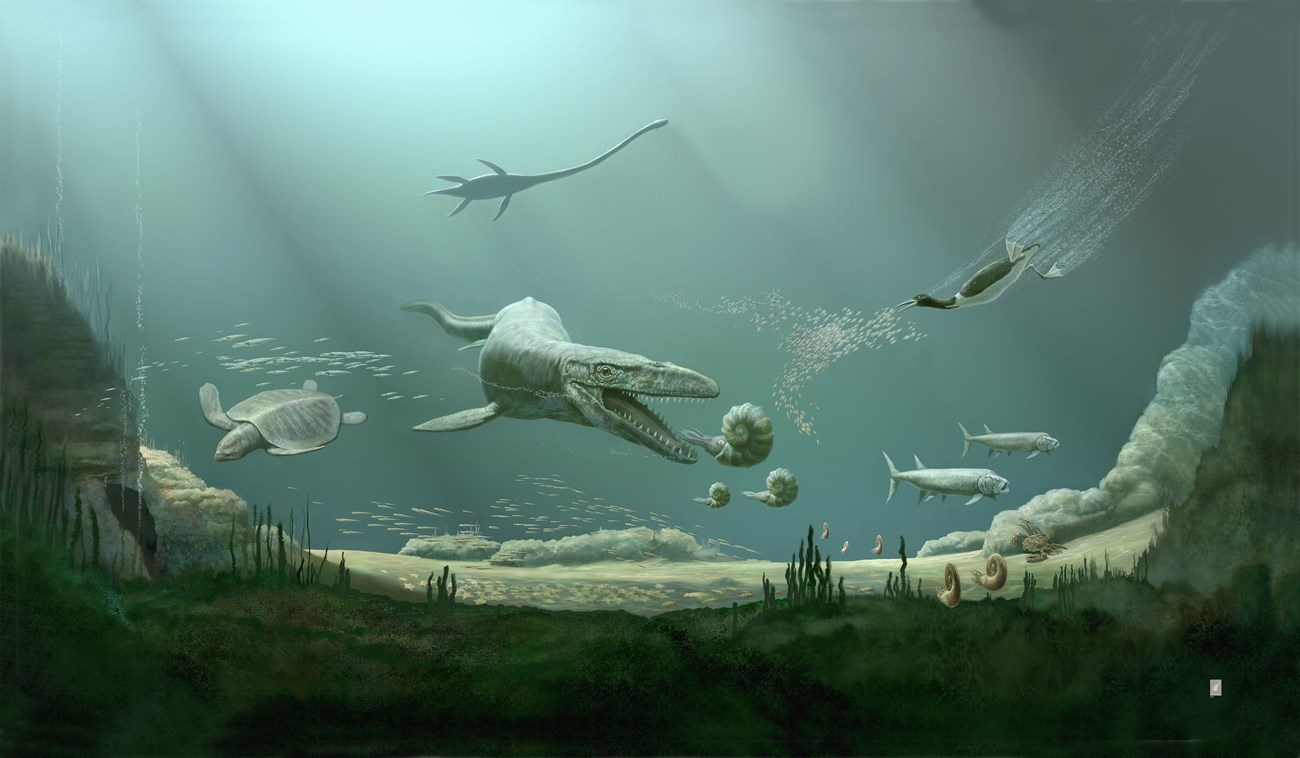
NPS image of mural by Karen Carr and Karen Carr Studio, Inc.
Introduction
Life on Earth began to look more modern in several important ways during the Cretaceous. The most notable change was the appearance, diversification, and spread of flowering plants. Flowers and fruit are powerful ways to improve how a plant species reproduces and disperses. Flowers attract insects and other small animals by the production of nectar; when the animal is feeding, pollen brushes off onto it and can be transferred to another flower to fertilize it. This is a more direct and selective process than other means of dispersing pollen, such as the wind. Fruit forms after fertilization and contains seeds. Animals that eat the fruit usually do not digest the durable seeds, which are left behind in droppings. Not only does this help to spread seeds over a large area, it also leaves the seeds with natural fertilizer. With all of these plant–animal relationships, you might guess that the evolution of flowering plants led to diversification of animals that could use either flowers or fruit, and you’d be right. Insects in particular benefited from the new plants.
In the air, diversifying flying insects were joined by the old standbys: the pterosaurs and the first major radiation of birds. Long-tailed pterosaurs were mostly extinct by the early Cretaceous, but other pterosaurs radiated greatly, reaching a high point during the mid-Cretaceous. Cretaceous pterosaurs included the largest known flying animals, the azhdarchids. Among them, the famous Quetzalcoatlus of Big Bend National Park could have a wingspan around 35 feet. It may have lived something like an enormous stork. Birds, which had evolved from small theropod dinosaurs during the Jurassic, took over the familiar size range of modern songbirds, although those birds wouldn’t evolve until later. From a distance, most Cretaceous birds would have looked similar to modern birds. If you could hold one, though, you’d be in for a surprise: many Cretaceous birds had teeth and wing claws. Many of the Cretaceous birds went extinct at the end of the period.
In the oceans, the dolphin-like ichthyosaurs, which had evolved back in the Early Triassic, died out during the middle Cretaceous. Their roles were filled in part by a new group, the mosasaurs, marine reptiles related to snakes and monitor lizards. The mosasaurs spread and diversified rapidly in the shallow seas that submerged large swathes of the continents during the Cretaceous. Long-necked plesiosaurs reached their extreme with the elasmosaurs, some having as many as 75 neck bones. Enormous marine turtles such as the car-sized Archelon evolved during the Cretaceous as well. In the realm of marine invertebrates, squid-like belemnites went extinct before the end of the period, but ammonites continued to the end and took on a variety of shapes besides the familiar coiled shells. Enormous clams called inoceramids, some up to 10 feet across, flourished at the sea floor. Another kind of bivalve, the cone-shaped rudists, grew in such large accumulations that they formed reefs.
On land, dinosaurs continued to dominate niches for terrestrial animals larger than a house cat. The semiaquatic realm was held by close crocodile relatives and, toward the end of the Cretaceous, true crocodilians. Mammals and their close relatives did not increase greatly in size, but they diversified. The Cretaceous was filled with early members of modern lineages (monotremes, marsupials, etc.). There were also various members of now-extinct groups, such as the rodent-like multituberculates that persisted into the early Cenozoic. The first good snake fossils come from the Cretaceous, but it doesn’t appear that they radiated until the Cenozoic.
Featured Articles
Site Index and Credits
Age of Dinosaurs (2021)
Text by Justin Tweet (AGI). Contributors: Vincent Santucci (GRD), Adam Marsh (PEFO), ReBecca Hunt-Foster (DINO), Don Corrick (BIBE). Project Lead / Web Development, Jim Wood (GRD).
References
-
Tweet, J.S. and V.L. Santucci. 2018. An Inventory of Non-Avian Dinosaurs from National Park Service Areas. in Lucas, S.G. and Sullivan, R.M., (eds.), Fossil Record 6. New Mexico Museum of Natural History and Science Bulletin 79: 703-730. https://irma.nps.gov/DataStore/Reference/Profile/2257153
-
Santucci, V.L., A. Marsh, W. Parker, D. Chure, and D. Corrick, 2018. “Age of Reptiles”: Uncovering the Mesozoic Fossil Record in three Intermountain national parks. IMR Crossroads. Spring 2018, p. 4-11. https://irma.nps.gov/DataStore/Reference/Profile/2253529
Last updated: July 8, 2022
